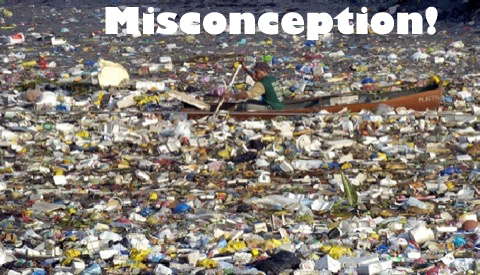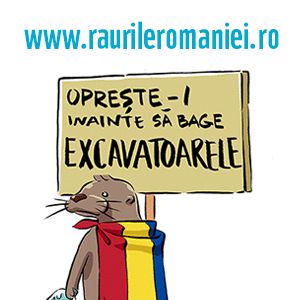Some days ago, I went to buy some cough syrup. The pharmacy lady was about to put the bottle in a plastic bag. “No bag for me, thanks! I can put the bottle in my backpack.”- I tell her. She answers kindly: “Don’t worry; the bag is for free, no need to pay for it!”
Among all the waste in our households, I think plastic is the nastiest and should concern us the most! Why? Because it’s non-biodegradable and its poor management will lead to mountains of trash (watch Wall-E to have a picture of that). Well, if we could only stop to that. But in fact, humans are even more wicked- they also send their plastic trash somewhere they cannot see it anymore… Out of sight- out of mind…
We allow our plastic-useless-former belongings to rest in a beautiful location, a place to which Earth owes being named „The BLUE Planet”. Yep… The Oceans. According to Greenpeace studies, 100 million tons of plastic are produced annually, from which 10% get into the planet’s oceans (80% of these coming from land- the other 20% coming from uneducated pirates).
One of the most severe examples of plastic pollution is the Pacific Garbage Patch (or the Pacific Trash Vortex) – in short PGP. This patch is an alarming phenomenon in the North Pacific, a huge vortex containing different plastic materials in small sizes, floating in the neustonic layer of the water (the surface layer- that is). We can clearly state that the PGP is one of the largest trash bins in the world (and it’s getting even larger!).
When they hear about the PGP, many people imagine that the water surface is covered in large size trash, as shown in this picture:
It’s not like that at all! The PGP is in reality a big soup of “millions of small and microscopic pieces of plastic”. Although researchers have found large plastic items as well, it’s the small ones (the size of a finger nail) that predominate. It’s not the size of the individual items that is concerning, but the small particles altogether! (To find out more about research results- check out this article and watch the video).
How does the PGP “work”? Significant quantities of small waste particles that come from land are brought into the ocean by the North Pacific Current, and then the surface currents (produced by the wind) catch the trash into a trap-like spiral, from which they cannot escape. Basically, the edges of the patch are active and attract more and more floating pieces, while the centre is calm and full of trash that will be stuck there forever.
Why is this plastic soup dangerous for the environment? Here are the main issues, I’ll try to explain them in short, since you took the time to read them and haven’t skipped to the conclusion yet.
- Disturbances in food chains: the tiny plastic particles are easily mistaken for phytoplankton, therefore animals such as Phoebastria nigripes (a species of albatross) or sea turtles can die due to ingestion of plastic. Check out this shaking video made by Chris Jordan!
- „Toxic sponge”: plastic particles are not biodegradable, but they are photodegradable- which is bad! It means light (and it’s plenty of it in the euphotic zone) helps them decompose to even smaller levels (molecular levels), transforming them into bisphenol A, polychlorinated biphenyls (PCB’s) and polystyrene derivatives, which are toxic and bioaccumulate in marine organisms! Therefore, once these molecules are consumed by the phytoplankton, they become part of the food chain and can eventually get into your yummy ocean fish dinner. Feed on that!
- Scary death traps (how awful is it to die like that??): a lot of various unlucky species get entangled in plastic trash (such as discarded fishing nets and nylon lines)… The followers of Jesus were fishermen, but now we’ve brought fishing to a whole new level… And let’s not forget the plastic bags- they are the new trend! Dolphins wear the fashionable “Thanks for shopping with us” around their necks…
[By the way- WHY ON EARTH would producers wrap Pomelo fruit individually in that unattractive plastic net?? Can someone explain this to me, please? I haven’t found an answer yet and my blood pressure gets high when I pass by the fruit isle…]
Research has shown that over one million marine birds and a hundred thousand marine mammals and turtles die annually due to plastic pollution (UNEP, 2006).
- Free rides for hitch-hiking organisms: larger floating objects (plastic recipients) can facilitate the transport of invasive species (“ocean hitch-hikers”- such as water skater insects, small crabs, barnacles) to other habitats or onto ship hulls, causing a lot of damage.
Conclusion
The Pacific Garbage Patch is a huge deposit of stinky indifference, sheer rudeness and big fat selfishness from our part… a burden that torments spectacular life forms, marine and winged alike. Unless you make Robo-Caps (see photo album), plastic is not a resource to mess around with!
Let’s come back to the pharmacy story.
Why shouldn’t I take the plastic bag I was offered for free? You’ll say that this specific bag will not get from Romania all the way into the Pacific. Then what might happen to it?
Well, it might:
- get to Glina (a Romanian not-so-well-managed waste deposit) and stay there for many many years, until Wall-E comes to the rescue;
- get into the Black Sea (along with our other many sins washed by the rain and carried by the rivers);
- get into a mail package I might be sending to my uncle Aurica in Canada, and from there, perhaps in the Pacific;
- get recycled if I feel a little creative- but how many ideas can one have for so many bags?
- Or I might not take it in the first place… (and if you do the same, they might not offer plastic bags anymore- NO TRADING- NO PRODUCTION!).
“- Thanks a lot, but I’d rather put the bottle in my backpack!”
[citeste aici varianta asemanatoare in limba romana]
Documentation
- UNEP (United Nations Environment Programme), RegionalSeas Report and Studies, Ecosystems and Biodiversity in Deep Waters and High Seas No. 17, 2006
- Greenpeace.org
- Scripps Institution- marine biologist Miriam Goldstein, research results
- Time to get drastic about plastic
- Chris Jordan http://www.midwayfilm.com/






















